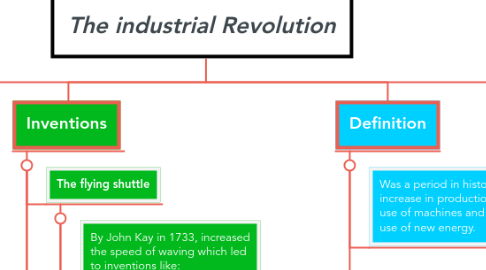
1. Origins
1.1. Birth place
1.1.1. The birthplace of the Industrial Revolution was in Britain due to its humid climate, ideal for breeding animals, especially sheep in which Britain adopted the history of the generation of textiles such as wool, linen, and cotton.
1.2. Agricultural revolution
1.2.1. 18th-19th century, the agriculture increased, sustained a massive population and carried trade.
2. Definition
2.1. Was a period in history in which the increase in production was brought by the use of machines and characterized by the use of new energy.
2.2. The "Industrial Revolution"term was used by the French writers but it became popular by the English economic historian Arnold Toynbee
3. Inventions
3.1. The flying shuttle
3.1.1. By John Kay in 1733, increased the speed of waving which led to inventions like:
3.1.2. The spinning jenny, water frame and power loom
3.2. First Locomotive
3.2.1. This transport created by Richard Trevithick’s carried ten tons of iron, seventy men, 9.75 miles (15.69 km) in four hours and five minutes.
3.3. Dynamite
3.3.1. Invented by a Swedish chemist in the 1860s. Alfred Nobel with his invention proved that dynamite was much stronger than gunpowder, this made dynamite gain more generalized use.
4. Steam Power
4.1. This icon of the industrial revolution made by Thomas Newcomen in the 1700s was the first modern steam engine.
4.1.1. This invention was first applied to power the machines used to pump water out of the mine shafts
